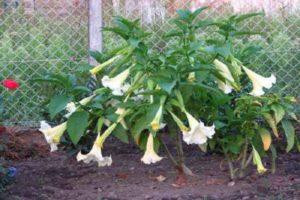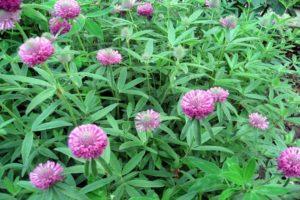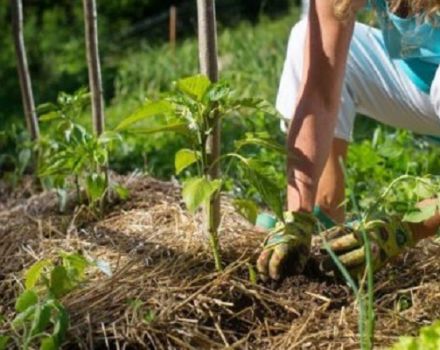Planting, growing and caring for marigolds in the open field
As practice shows, bright, with many small inflorescences, marigolds are unpretentious in cultivation. Plant seeds are purchased in retail chains, garden stores. Plants will need a lot of light when growing, so it is best to plant them in areas that are open to the sun. But even in the shady twilight, they will not stop growing. The flowers are perennial, so the seeds will be needed for the very first planting.
Content
- 1 Description and features of the plant
- 2 Can marigolds be sown in autumn?
- 3 Benefits of autumn planting
- 4 Planting preparation
- 5 Sowing process
- 6 How to care for marigolds during cultivation
- 7 Disease and pest control
- 8 The combination of marigolds with other plants
- 9 Collection and storage of marigold seeds
Description and features of the plant
Marigolds have several different species that differ from each other in appearance, size, color. The planted plant will be guaranteed to exist for more than one year, which is why marigolds are so popular with amateurs and experienced gardeners. The leaves are green, shade from light to dark, cut along the edges (feathery, dissected). On the stem, foliage is arranged in an orderly manner, this is one of the signs of a plant.
The height of the bush ranges from 20 centimeters to 2 meters. The stem is powerful, straight. The inflorescence is formed by a combination of tubules and tongues - this is how marigolds bloom.
By the number of petals, their appearance, the following types are distinguished:
- Regular or non-double. Contain up to 3 reed rows of inflorescences.
- Semi-double. Their tongue-shaped petals occupy about half of the total.
- Terry. This group includes anemone-like, carnation and chrysanthemum marigolds. Each of them will have more than half of the tubular (reed) petals in the inflorescence.
The plant has a harsh, peculiar smell, which is compensated by the richness of colors and types. The growing season lasts from June to October (until the first frost). The natural result of flowering will be the formation of a seed box, there are placed from 2 to 7 hundred seeds per gram of weight. Germination capacity lasts for years. Perennial marigolds bloom in various shades, from pure white to mixed variegated.
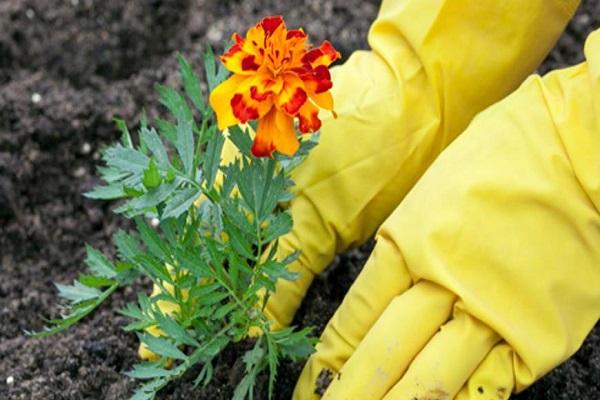
Can marigolds be sown in autumn?
Most sources authoritatively state that marigolds are sown only in spring. The arguments are strong: the plant is thermophilic, it does not tolerate frost well. And in order for the landing to give a positive result, a certain temperature regime is required - not lower than plus 5 on the Celsius scale.
So beginner gardeners plant marigolds exclusively in the spring, missing out on the opportunity to experiment.The overwhelming majority of fans of marigolds will recommend exactly the "spring" method, as a familiar and fully justified.
Meanwhile, the winter planting of plants is no worse. The main thing is to know how to sow marigolds.
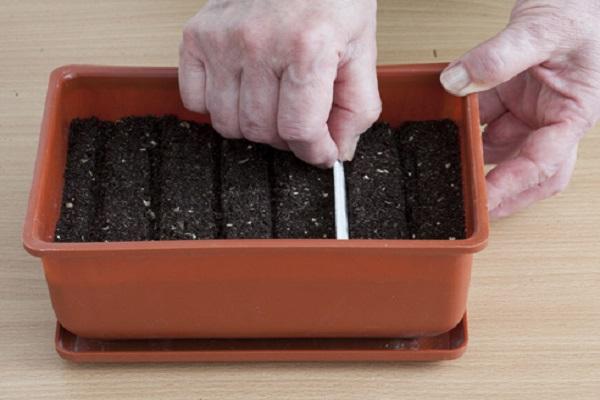
Benefits of autumn planting
When deciding when to plant seeds, which planting is preferable - autumn or spring, many, without hesitation, will choose the latter. And they will bring strong, iron arguments in defense of their position. It seems that everything is so, but not quite.
Planting in autumn has the following advantages:
- during hibernation, plants gain strength, get used to life in the open outside world;
- the formation of the root system of marigolds due to early planting is faster;
- there is no need to select the "correct" planting date, by the warm season the flowers develop independently, growing from seed to seedling.
A serious disadvantage of cold planting is the increased use of seed stocks. You need to be prepared for this in order not to get into a mess.
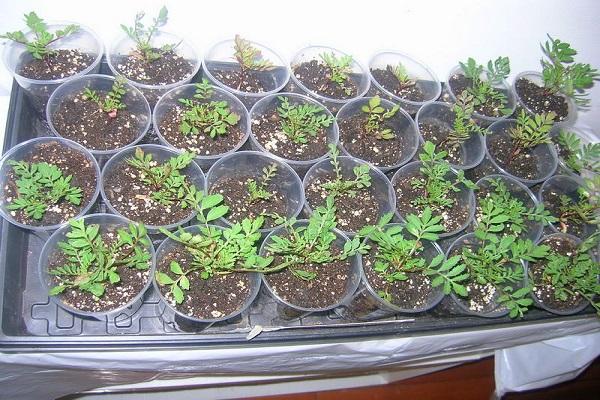
Planting preparation
It starts with choosing a place. It is important to take into account 2 points here: the absence of liquid stagnation and a planned slope on the site. Additional nuances relate to the ground. It should be loose and permeable rather than dense. The latter circumstance automatically solves the problem of waterlogging.
Therefore, preparations for planting plants begin with bringing the soil to the required consistency state. For this, soil, peat, river sand and humus (compost) are mixed. The next subtlety is landing in frozen ground, not cold ground. The preparation of the landing site (excavation of grooves and holes, mixing) is carried out in September, and already with the onset of cold weather, seeds will lay in them.
Seed selection
The seed fund of plants is selected based on the color range, varieties (if purchased). Or they use the seeds collected in the fall from their plantings, selecting large and healthy ones. Germination ability remains up to 3 years. Treatment with a stimulant (soaking in water) increases the chances of biting, at the same time reducing the appearance of the first shoots by 5-7 days.
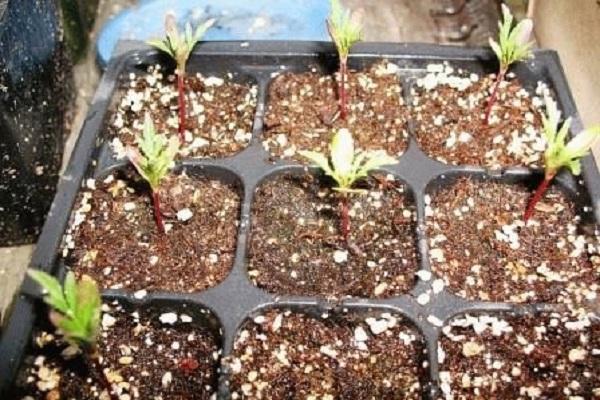
Lulu, Golden Jam, Gnome, Bonanza Orange, Flame, Carmen, Antigua or Kilimanjaro are chosen more often than others.
Seat selection
It depends on the place whether the seeds will sprout, full-fledged plants will develop from them or die. It is desirable that it be a site with a slight slope, not too saturated with moisture. The soil will most likely have to be replaced with a complex composition. This will increase the permeability of the mixture, allow you to get rid of excess water (melt or during watering).
It was not possible to plant immediately in a sunny, open place - it does not matter. Marigolds allow a transplant after they are taken, let the leaves go and strengthen the root system.
Sowing process
Before sowing, the plants determine its timing: whether it will be winter or spring. Also, depending on the choice made, they plan to plant in open ground, immediately to their "permanent residence" or in planting pots, so that later, when the seedlings are formed, move them to the flowerbed.
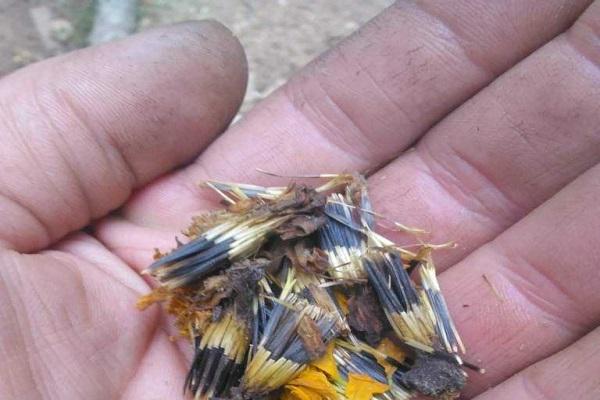
In open ground
A standard open ground planting implies 2 options. Which one is to the liking of the gardener, he decides for himself. This is sowing in spring or autumn.
To implement the first method, a suitable time is selected (such as when the night temperature does not drop below plus 5 degrees). At first, the plants are planted shallow. Be sure to observe the step between future bushes one and a half to two centimeters. With a sparse landing, marigolds will begin to grow, they will become long and sluggish, too frequent - they will jam each other. The planted seeds are sprinkled on top with a layer of soil (up to 1 centimeter), watered.
It is advisable not to be zealous with the water regime so that the seedlings do not rot.After pecking the first 2-3 leaves, transplanting with a deepening into the ground is allowed.
Sowing of plants in the winter is different in that the seeds fall into frozen, cold ground. They take them 2 times more, taking into account possible losses. Fresh plantings are covered with a layer of soil, mulched. In the spring, the sprouts that have hatched are planted, relocated to a new place, or thinned out.
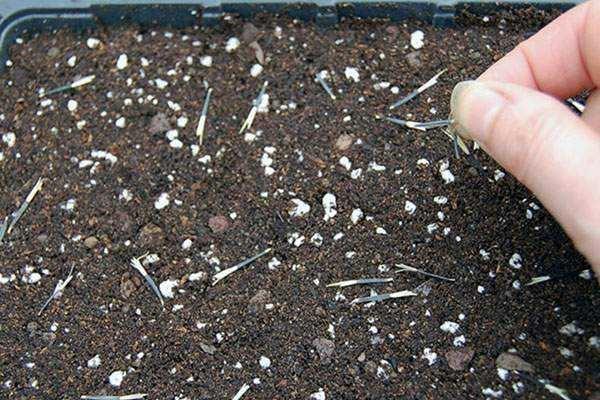
In pots
In addition to the known methods of planting velvet flowers immediately into the soil, others are used in horticultural practice. Plant the plants in pots (in early spring), wait for their normal development, and send them to the flowerbed in May. The method, in fact, is simple, does not require deep knowledge and excessive expenditure of energy. It is necessary to provide future bushes with warmth and light, as well as regular, but not excessive watering.
Planting times vary from variety to variety. Straight large-flowered or thin-leaved plants are planted in early March, rejected - in the same month, but closer to the end. Subject to these conditions, marigolds will bloom in May-June.
When cultivating seedlings, it is important not to miss the moment when it will outgrow (begin to bloom). Such bushes are reluctant to take root in a new place. The situation can be corrected by mechanically removing the buds.
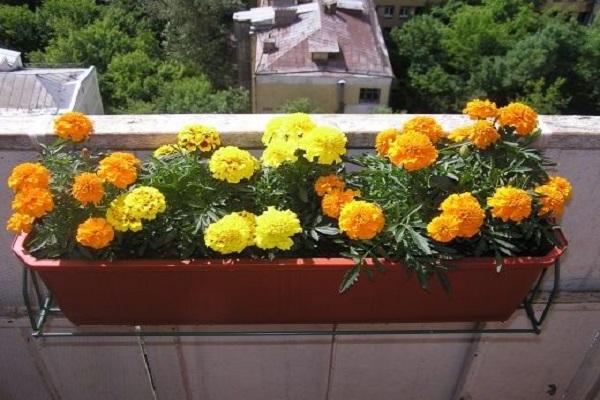
How to care for marigolds during cultivation
Caring for seedlings consists in carefully observing the light regime, obtaining sufficient heat, and timely watering. Weak, rotten shoots are removed, at the same time (if necessary) thinning is carried out. Once the seeds are sown, the pots are placed in a shaded area with a constant temperature of 18-20 degrees. You can use a film or cover with a sheet of plastic, periodically opening the boxes for ventilation.
When sprouts appear, the seedlings of marigolds are transferred to a lighter place (on the windowsill), not forgetting to cover them from direct sunlight. The temperature regime in this case is 17-18 degrees Celsius. These are optimal indicators so that the seedlings do not burn out and rot.
It is allowed to "walk" the seedlings of marigolds, take them out into the fresh air, trying to protect them from drafts. Top dressing is welcome, there should be several. Watering the plants is carried out in moderation, so that root rot, the development of fungi and mold does not occur.

Watering and feeding
Watering the growing marigolds, it is important not to overdo it. Plants should get enough fluid, but not too much. To avoid water accumulation, it is helpful to use a box with a sump or periodically drain the excess after watering. For additional nutrition of marigolds, complex preparations (water-soluble) are used.
At the first feeding, it is permissible to use Kristalon (green) - a modern universal means for plant nutrition. It is carried out approximately 10-14 days after the seedlings emerge. 5-6 days before the planned planting in the ground, marigold seedlings are once again watered with a solution of yellow Crystal.
Such a step will help to transfer stress and will have a positive effect on strengthening the roots of marigolds. After the seedlings have taken root, they are also fed. It is advised not to do this very often so that the plants do not grow to the detriment of flowering.
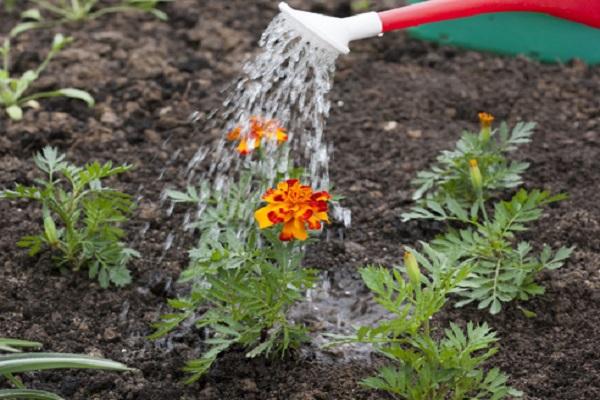
Despite the fact that the plant belongs to the unpretentious, perfectly bypassing the nutrients laid down in the soil, an additional portion of fertilizers will not harm it. It is only important not to exceed the dose.
Weeding and loosening row spacings
Experienced gardeners know about the benefits of loosening plantings with plants: this way the roots are provided with oxygen in the required amount. Marigolds are not an exception, but a confirmation of this simple rule. Only with them loosening can be combined with weeding, destruction of weeds, weak shoots.
Until the marigold seedlings have matured, they are exposed to unwanted pest neighbors.Gradually, as they grow, marigolds will learn to defend themselves. All that remains is to regularly loosen the beds and break up the soil lumps.

Preparing for winter
If you do not plan to collect seeds, move marigolds to another site, they are able to transfer the winter. The plants are covered with foil, sprinkled with foliage, small branches. For a mild southern winter in Central Russia, this will be enough to keep velvet flowers until spring. When harvesting a plant "for seeds", the marigold bushes are dug up, transferred to a warm, dry place, where they are kept until the stems darken.
Disease and pest control
The tart aroma of flowering marigolds guarantees protection against fungal pathogens, so they can be used as a prophylactic agent to ensure the safety of nearby growing garden plantings.
But the plants themselves are vulnerable to pests and diseases. With insufficient watering, there is a possibility of the appearance of a spider mite. Excessive moisture in marigolds is accompanied by rot, the development of fungi.

It is treated in the opposite way: dryness - by moistening and spraying, rot - by drying, transfer to a warm place. When slugs or snails appear on plants, it is better to refrain from chemical treatment in order to avoid shedding flowers from marigolds.
Gray rot occurs when marigolds freeze, are in a damp, excessively humid atmosphere. Signs of the disease are brown wet spotted formations. It is recommended to immediately isolate diseased plants and then destroy them so as not to harm healthy ones.
"Spoiled" marigolds can be used to scare off pests: if they are thrown into compost, then midges and parasites will never start there.
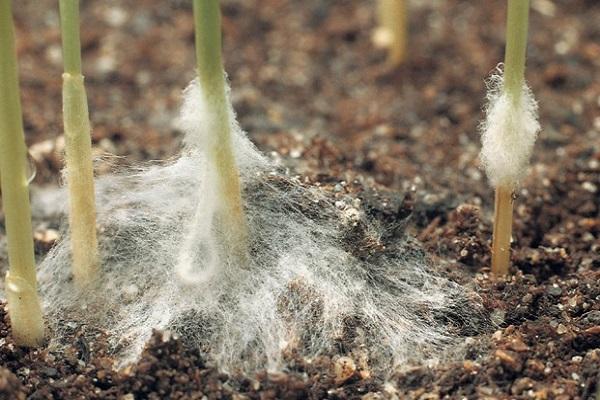
The combination of marigolds with other plants
From velvet flowers, wonderful flower beds are obtained, forming carpet paths and whole areas in combination with begonias, asters, cineraria or ageratum. In addition to decorative purposes, marigolds perform a very real function: they protect areas of the garden from the penetration of pests, scaring them away from plants with their smell. Bright, yellow-red inflorescences of black-shaved ones go well with purple, blue or light blue asters.
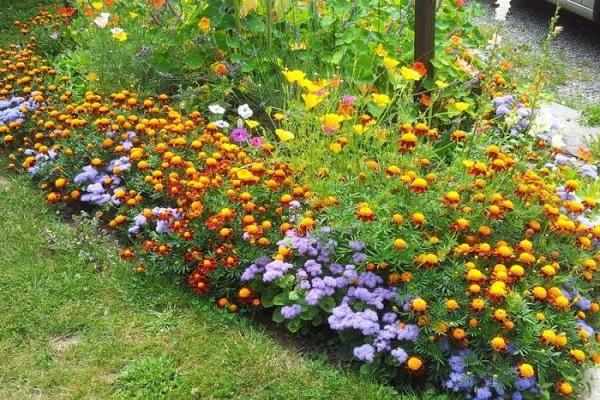
Collection and storage of marigold seeds
Black-shaved plants are annual plants, but their existence is easy to prolong if you collect, save the seeds, and then sow again. Inflorescences in plants are female and bisexual. The latter do not need additional pollination, they give the most seeds. At the same time, the qualities of velvety, terry petals are obtained from "female" seeds. The choice of the source of obtaining the seed of the plant depends on this.
The average ripening time for marigold seeds is 40 days or more. As soon as the inflorescences began to turn yellow, and the stems of the plant have acquired a brown color, you can harvest the "harvest". For this, the flowers of marigolds are cut, trying not to damage, then the seeds are poured into a bag or envelope. The collection is carried out in dry, calm weather. Storage is carried out in a warm place with normal humidity in order to avoid decay of marigold seeds. They are stored for several years, completely retaining their properties.
